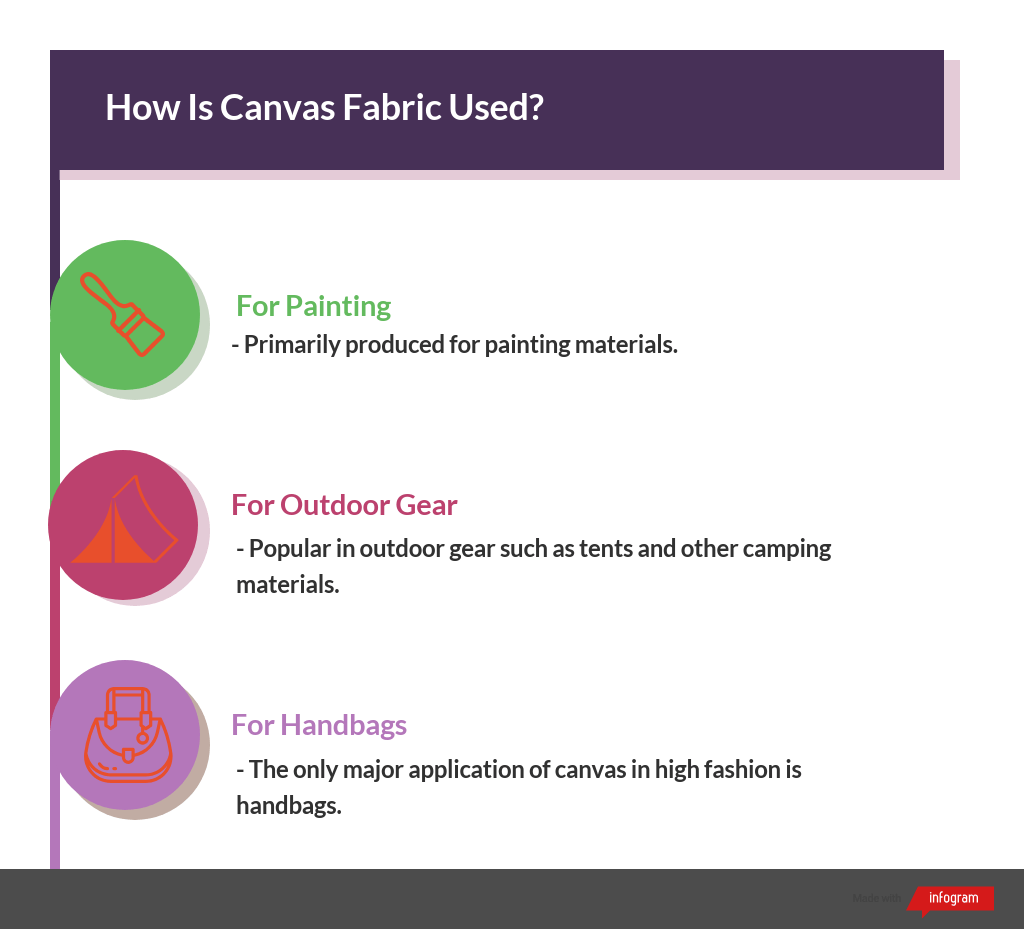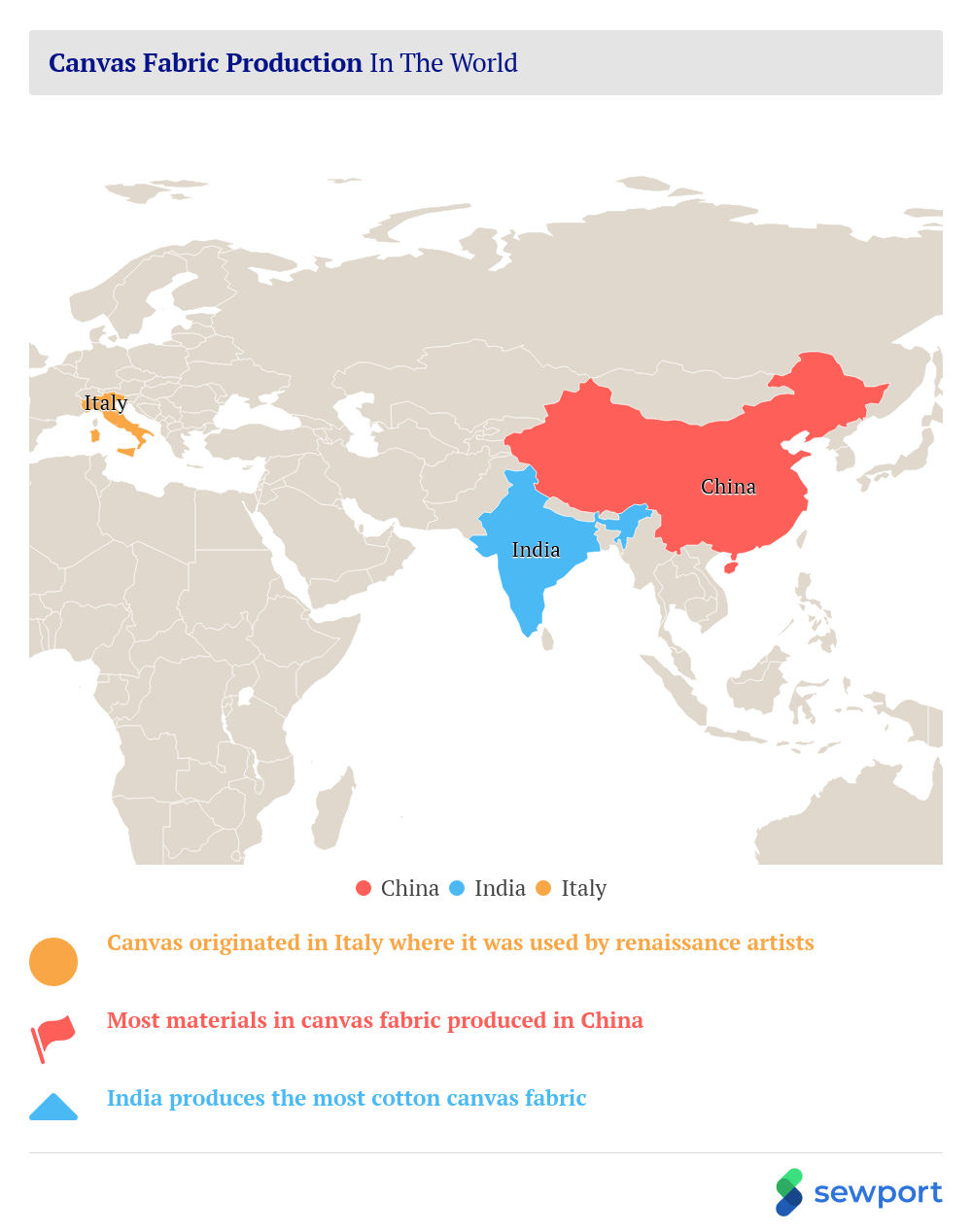| Fabric name | Canvas |
| Fabric also known as | Duck, tarp, fly, awning cloth, tenting |
| Fabric composition | Plain-weave cotton or linen treated with PVC or gesso |
| Fabric possible thread count variations | 50-100 |
| Fabric breathability | Low |
| Moisture-wicking abilities | High |
| Heat retention abilities | High |
| Stretchability (give) | Depends on the material used |
| Prone to pilling/bubbling | Low |
| Country where fabric was first produced | Italy |
| Biggest exporting/producing country today | China |
| Recommended washing temperatures | Medium to hot |
| Commonly used in | Bags, sails, tents, tarps, pants, jackets, upholstery covers, art supplies, backpacks, handbags, shoes |
 Rustic Bronze Copper Brown 8 oz cotton canvas fabric by the yard mask fabric
Rustic Bronze Copper Brown 8 oz cotton canvas fabric by the yard mask fabric
What is canvas fabric?
Canvas is a plain-weave, heavy-duty fabric that is commonly desired for its water-resistance. Originally popularized as a useful sail cloth material and an excellent painting medium, canvas has now made its way into applications as widespread as tent material, casual shoes, and designer handbags. Most canvas currently on the market contains cotton fibers, but traditionally, this fabric was made with hemp or linen.
Canvas technical specifications
Featuring thick yarn, canvas is tightly woven in a simple plain-weave pattern. While this fabric is similar to denim due to its thickness and durability, denim features a twill weave.
Due to the thickness of its yarn, the thread count of most canvas fabrics is low. Most canvas has a thread count of 50 to 100 with higher thread counts sacrificing durability in exchange for a softer texture.
While cotton is currently the most popular canvas material, it’s still possible to make this fabric with hemp or linen. Canvas is naturally water-resistant, and contemporary forms of industrial canvas commonly feature polyvinyl chloride (PVC) coating on one or both sides for additional waterproofing.
 9.3 Oz Navy Blue Cotton Canvas Fabric
9.3 Oz Navy Blue Cotton Canvas Fabric
History of canvas
Canvas was originally popularized as a painting medium among Venetian Renaissance artists. Venice was the epicenter of the Italian Renaissance, and painters in this watery city struggled to create works of art on frescos and wood panels due to the high ambient humidity.
Long before it came into popularity as a painting medium, canvas had been the default material for making sailcloth for millennia. The farther we go back in history, the looser the definition of “canvas” becomes, but even the most rudimentary Ancient Egyptian sails bear close resemblance to modern canvas sailcloth.
Since Venice was already the center of the Italian maritime industry, Renaissance painters had little trouble repurposing canvas sailcloth for the purpose of fine art. Back in those days, however, hemp was the primary material used to make canvas, and it remained the most popular canvas fiber for quite some time.
In fact, historians believe that the word “canvas” comes from either the Greek or Latin word for “cannabis.” With the blossoming of the Indian cotton trade that began in the 17th century, European hemp production declined, but the very name of canvas fabric remains a fascinating reminder of this textile’s hempy origins.
 Canvas Fabric - Cotton + Steel - Amalfi - Herb Garden Midnight
Canvas Fabric - Cotton + Steel - Amalfi - Herb Garden Midnight
Canvas today
While wood panels tended to warp and crack, paintings on canvas exhibited remarkable resistance to time and the elements, and canvas soon became the most popular painting medium throughout Europe. All of the late Renaissance period’s most important paintings were painted on canvas, and canvas remains a popular painting medium to this day.
Throughout the centuries, canvas never lost its popularity as a sailcloth material. While modern sails sometimes feature synthetic fibers, cotton and linen canvas remain popular choices for sailcloth. Canvas gradually made its way into other outdoor-oriented applications, and for centuries, it was the most popular material for tents and other forms of temporary shelters.
At some point, canvas started making its mark the arena of fashion accessories and apparel. Today, it’s as common to find expensive designer handbags that incorporate canvas as it is to find canvas-exterior cold-weather work gear. Despite the plenitude of synthetic materials now available, most types of canvas used in apparel remain cotton-based.
How is canvas fabric made?

The process used to make canvas fabric differs depending on the fabric’s intended purpose. Canvas fabric intended for painting goes through additional post-production processes. Despite the fact that textile manufacturers can make canvas from cotton, linen, or hemp, each of these fibers have similar attributes, so the basic production processes used to make canvas remain the same regardless of the selected fiber.
1. Yarn production
Canvas incorporates unusually thick yarn, and it is not usually necessary for this yarn to be very soft. For these reasons, textile manufacturers commonly use the rougher fibrous parts of the cotton, linen, and hemp plants to make canvas yarn. This yarn is usually carded instead of combed since softness is not a relevant factor.
2. Weaving
Canvas is a plain-weave fabric, which means that it consists of weft threads that alternate under and over warp threads. Some types of canvas have closer weaves than others, but each type of canvas features a weave that is close enough to render the resulting fabric opaque.
 Sunbrella Canvas Canvas Fabric
Sunbrella Canvas Canvas Fabric
3. Finishes
If woven canvas will be used for industrial applications, a layer of PVC is often applied to its outer surface. This step is optional, however, and all-natural forms of canvas exist that do not feature PVC or any other synthetic chemicals.
If intended for painting, textile manufacturers will bleach finished canvas and apply a layer of gesso. Canvas used for sails is usually unbleached, and canvas used for tents, apparel, and other purposes may be dyed.
4. Painting canvas processes
If canvas will be used for painting, it is stretched around a wooden frame before gesso is applied. This stretching process ensures that the canvas forms a perfectly taut and flat painting surface. Expert canvas stretching also ensures that the warp and weft threads in the canvas form a perfect grid.
How is canvas fabric used?

In the modern era, canvas is primarily produced for painting materials. While some sailboats still feature canvas sails, sailboats are not very popular in this era, and many modern sailors have replaced their canvas sails with synthetic alternatives.
Canvas also remains somewhat popular in the world of outdoor gear. Most contemporary tents feature synthetic materials, but some camping purists swear by the benefits of genuine canvas tents. Similarly, some outdoors enthusiasts believe that canvas tarpaulins are better than their synthetic alternatives.
 Waterproof Canvas Solid BROWN Indoor Outdoor Fabric 60 Wide Sold by the yard
Waterproof Canvas Solid BROWN Indoor Outdoor Fabric 60 Wide Sold by the yard
In the apparel industry, canvas is primarily used to make outdoor gear and work garments. A variety of popular brands, for instance, make winter work jackets that feature canvas outer layers. These coats are especially popular in parts of the American West where winters are very cold but generally dry.
The only major application of canvas in high fashion is handbags. Some of the world’s most coveted handbags feature canvas exteriors, and this material’s resistance to water and stains provides it with desirable longevity. In the world of casual wear, designers sometimes use canvas to make shoes, the most notable being Converse’s original high-top sneakers.
Where is canvas fabric produced?

Cotton is the most popular material for canvas production, and India is the world’s largest producer of cotton. However, this nation does not produce nearly the same number of finished textile products as its neighbor China, which leads the world in overall textile exports.
While India is likely the source of much of the cotton found in canvas fabric, Indian cotton cultivators usually send their unprocessed crops to China for finishing. Though some forms of canvas do not contain cotton, China is also the world’s largest producer of linen and industrial hemp fiber. If you possess any canvas fabric, it is highly likely that your canvas was made in China.
How much does canvas fabric cost?
Linen and cotton canvas are usually among the least expensive forms of natural fabric on the market. Even though hemp was once the world’s most abundant and most-used fiber crop, canvas made from hemp is now usually more expensive. Prices for canvas vary depending on the seller.
What different types of canvas fabric are there?

There are a few subtypes of canvas fabric that each have unique properties:
1. Plain
Plain canvas has a thread count between 50 and 100. It consists of rough, wide fibers with a relatively loose weave. This type of canvas is most appropriate for industrial purposes since it has a rough hand and can be abrasive when worn against the skin.
2. Duck
Duck is a type of canvas that features thinner threads and a closer weave. This type of canvas has a smoother hand, and it is more appropriate for apparel and other types of fabric products that touch the skin. While softer and finer than plain canvas, duck shares the water-resistant properties of its parent fabric. Duck may have a thread count of 100-150.
3. Cotton
Most canvas fabric on the market contains cotton fibers. Compared to linen and hemp, cotton is stretchier, and it is both fluffier and smoother to the touch. At the same time, cotton is less durable than either linen or hemp.
 Ottertex Waterproof Canvas Burgundy
Ottertex Waterproof Canvas Burgundy
4. Linen
Ancient Egyptian sailmakers used linen to make their canvas, and while this fiber isn’t commonly used to make sails anymore, artists prize linen canvas for its rigid durability. Linen canvas may last longer than cotton canvas.
5. Hemp
Hemp is the most durable material that textile manufacturers can use to make canvas. Like linen, hemp is inflexible and wear-resistant, but like cotton, this material has a soft hand. Regulatory restrictions currently limit the use of hemp for canvas production.
How does canvas fabric impact the environment?
Since canvas primarily contains natural materials, the production of this material has a relatively low negative impact on the environment. Gesso, the finishing material that is applied to painting canvas, commonly consists of a mix of natural and synthetic materials, and PVC is a fully synthetic material with a remarkably negative environmental impact.
During the production of PVC, toxic phthalates are released into the manufacturing environment, and this plastic can produce the environmental pollutant dioxin if it is disposed of incorrectly. Gesso, for its part, features either rabbit-skin glue or a synthetic alternative, and these materials are undesirable for moral and environmental reasons respectively.
The production of linen, cotton, and hemp have the potential to be environmentally neutral when performed correctly. All too often, however, textile crop producers deploy toxic agricultural chemicals, which harm surrounding ecosystems. To ensure that your canvas is environmentally friendly, choose fabric that is organic and not coated with PVC.
Canvas fabric certifications available
There are no certifications specifically for canvas fabric. While PVC used in canvas may be eligible for International Organization of Standardisation (ISO) certification, it is more environmentally friendly to choose non-PVC canvas products.
